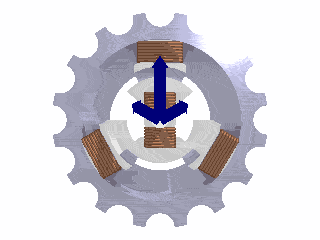 | ||
A rotating magnetic field is a magnetic field that has moving polarities in which its opposite poles rotate about a central point or axis. Ideally the rotation changes direction at a constant angular rate. This is a key principle in the operation of the alternating-current motor.
Contents
Rotating magnetic fields are often utilized for electromechanical applications such as induction motors and electric generators. However, they are also used in purely electrical applications such as induction regulators.
Description
A symmetric rotating magnetic field can be produced with as few as two polar wound coils driven at 90 degrees phasing. However, 3 sets of coils are nearly always used because it is compatible with a symmetric 3-phase AC sine current system. The three coils are driven with each set driven 120 degrees in phase from the others. For the purpose of this example, the magnetic field is taken to be the linear function of the coil's current.
The result of adding three 120-degrees phased sine waves on the axis of the motor is a single rotating vector which remains always constant in magnitude. The rotor has a constant magnetic field. The N pole of the rotor will move toward the S pole of the magnetic field of the stator, and vice versa. This magneto-mechanical attraction creates a force which will drive the rotor to follow the rotating magnetic field in a synchronous manner.
A permanent magnet in such a field will rotate so as to maintain its alignment with the external field. This effect was utilized in early alternating current electric motors. A rotating magnetic field can be constructed using two orthogonal coils with a 90 degree phase difference in their AC currents. However, in practice such a system would be supplied through a three-wire arrangement with unequal currents. This inequality would cause serious problems in the standardization of the conductor size. In order to overcome this, three-phase systems are used where the three currents are equal in magnitude and have a 120 degree phase difference. Three similar coils having mutual geometrical angles of 120 degrees will create the rotating magnetic field in this case. The ability of the three phase system to create the rotating field utilized in electric motors is one of the main reasons why three phase systems dominate in the world electric power supply systems.
Rotating magnetic fields are also used in induction motors. Because magnets degrade with time, induction motors use short-circuited rotors (instead of a magnet) which follow the rotating magnetic field of a multicoiled stator. In these motors, the short circuited turns of the rotor develop eddy currents in the rotating field of the stator which in turn move the rotor by Lorentz force. These types of motors are not usually synchronous, but instead necessarily involve a degree of 'slip' in order that the current may be produced due to the relative movement of the field and the rotor.
History
In 1824, the French physicist François Arago formulated the existence of rotating magnetic fields using a rotating copper disk and a needle, termed Arago's rotations. English experimenters Charles Babbage and Charles Herschel found they could induce rotation in Arago's copper disk by spinning a horseshoe magnet under it with English scientist Michael Faraday later attributing the effect to electromagnetic induction In 1879 English physicist Walter Baily replaced the horseshoe magnets with four electromagnets and, by manually turning switches on and off, demonstrated a primitive induction motor.
Practical application of a rotating magnetic field in an AC motor is generally attributed to two inventors, the Italian physicist and electrical engineer Galileo Ferraris, and the Serbian-American inventor and electrical engineer Nikola Tesla. Tesla claimed in his autobiography that he identified the concept in 1882 while Ferraris wrote about researching the concept and built a working model in 1885, although there is no independent verification for either claim. In 1888 Tesla obtained a United States patent (U.S. Patent 0,381,968) for his design and Ferraris published his research in a paper to the Royal Academy of Sciences in Turin.
